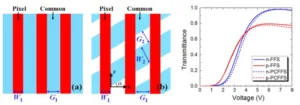Fringe Field Switching (FFS) is the name given to an electro-optical effect that is utilized in a type of Liquid Crystal Display that is found in a wide variety of consumer products.

The reason that this electro-optic effect has been so broadly adopted is that it provides a wide viewing angle, supports high resolution, consumes low power and minimizes visualization of the pressure associated with the touch on an adjacent touch panel. There is, however, one particular aspect of the FFS effect that is in need of improvement: the effect’s relatively “slow” speed of response. The manifestation of slow response speed in a FFS based LCD is that fast moving objects may exhibit motion blur. This issue is being addressed by a team of researchers headed by Daming Xu of the College of Optics and Photonics at the University of Central Florida (Orlando, FL).
The most recent results published by the team was presented in an article entitled “A Fringe Field Switching Liquid Crystal Display with Fast Grayscale Response Time”. It was published in the Journal of Display Technology, Vol. 11, No. 4, April 2015. The article is available online and can be found here.
In this most recent work, the team proposes a variation on the conventional FFS mode based on the inclusion of a Patterned Common electrode. The configuration is illustrated in the left hand part of the illustration below. The team refers to the new mode as PCFFS. The mode can be configured to work with either so-called positive (p) or negative (n) liquid crystal materials.
In both cases, the bright and the dark states are achieved by applying fringe fields. Although the direction of the fringe fields are different, in both cases, the application of a restoring voltage pulse on the neighboring common electrodes is configured to act in concert with the elastic relaxation of the liquid crystal directors. In this way, a driving force is added to means used to return the directors to their initial alignment conditions thus making the return faster.
With the new configuration and mode of operation, the team has been able to increase the average speed to transition from a first grey scale level to a second grey scale level by a factor of seven for n-PCFFS LCD as compared to a conventional FFS LCD. The average grey scale level to grey scale level speed for p-PCFFS LCD was determined to be a factor of eight faster than that in a conventional FFS LCD.
Another important device characteristic is the voltage-transmission response as illustrated in the graph presented above. As shown, the PCFFS effect exhibits nearly identical voltage-transmission characteristics to that of a conventional FFS LCD. Of equal significance is the fact that the PCFFS LCD is reported as not exhibiting negative tradeoffs in other desirable aspects of electro-optic performance as compared to a conventional FFS LCD. In fact, the team’s recent research paper presents a great deal of information on the other aspects of PCFFS device electro-optical performance. This data derives from device simulations. One result of practical interest is that a thinner passivation layer is desirable in that it reduces the required restoring voltage. Perhaps of even greater significance since it relates to manufacturing, is the fact that a PCFFS based LCD is reported as possessing “a large fabrication tolerance”.
The work undertaken by the team address a real world display problem and their results are strongly positive. It would seem that PCFFS is a good candidate to find application in real, commercial LCDs. – Arthur Berman
University of Central Florida, Daming Xu, 407-797-0652, [email protected]

